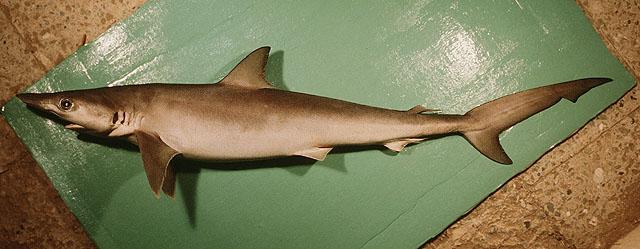In a groundbreaking marine discovery, researchers have documented the first-ever sighting of a sliteye shark in the remote waters of the Chagos Archipelago, located in the Indian Ocean. This unprecedented observation, reported through EurekAlert!, marks a significant expansion of the known habitat for this elusive shark species, offering new insights into the biodiversity of one of the world’s most pristine marine environments. The finding not only underscores the ecological importance of the Chagos Archipelago but also highlights the continuing need for exploration in the planet’s least accessible ocean regions.
Sliteye Shark Sighting Marks a Breakthrough in Marine Research in the Chagos Archipelago
Marine biologists conducting a recent survey in the remote waters of the Chagos Archipelago have recorded the first-ever sighting of the elusive Sliteye Shark (Loxodon macrorhinus) in this pristine ecosystem. This discovery not only expands the known geographical range of the species but also highlights the rich biodiversity protected within the Indian Ocean’s marine reserves. Researchers emphasize that such findings are crucial for understanding shark migration patterns and the overall health of coral reef habitats in this isolated region.
The sighting opens new avenues for conservation and scientific study, as the Sliteye Shark is known for its unique eyes adapted to low-light environments and its role as a mid-level predator maintaining reef balance. Key highlights from the observation include:
- Location: Southern lagoon, Chagos Archipelago
- Depth recorded: Approximately 30 meters
- Behavioral notes: Solitary, slow-moving near coral outcrops
- Significance: Indicator of reef ecosystem health
| Aspect | Details |
|---|---|
| Research Team | Chagos Marine Survey Consortium |
| Survey Duration | March – April 2024 |
| Equipment Used | Underwater ROV & HD Cameras |
| Next Steps | Tagging and ongoing monitoring |
Detailed Analysis of Sliteye Shark Habitat and Behavior in the Remote Indian Ocean
The recent discovery of the Sliteye shark in the Chagos Archipelago sheds light on the species’ adaptability to the less-explored habitats of the remote Indian Ocean. This elusive shark, previously undocumented in this region, was observed primarily around coral reef slopes and lagoon waters, suggesting a preference for structurally complex marine environments. Researchers noted that the shark’s behavior is closely tied to these microhabitats, where it uses the reef’s crevices for shelter and hunting grounds. The species’ presence indicates a potentially critical ecological connection between mid-level predators and the biodiversity hotspots of the area.
Observational data gathered during the expedition illuminated several key behavioral traits:
- Nocturnal hunting patterns: The Sliteye shark is predominantly active during low-light conditions, preying on small fish and crustaceans.
- Territorial behavior: Sightings suggest an established home range around specific reef segments, with minimal displacement over time.
- Solitary nature: Unlike many shark species that form groups, Sliteye sharks appear to prefer solitary roaming.
| Attribute | Details |
|---|---|
| Habitat Depth | 15 – 45 meters |
| Preferred Environment | Coral reef slopes & lagoons |
| Diet | Small fish, crustaceans |
| Activity Period | Primarily nocturnal |
| Social Behavior | Solitary |
Experts Call for Enhanced Protection Measures to Preserve Sliteye Shark Populations
The recent discovery of the sliteye shark in the remote Chagos Archipelago has raised alarms among marine conservationists, urging immediate action to safeguard this elusive species. Experts emphasize that despite the shark’s resilience, escalating threats such as illegal fishing, habitat degradation, and climate change jeopardize its survival. Protection efforts must focus on creating robust marine reserves that restrict disruptive human activities and promote ecosystem restoration.
Key recommendations proposed by specialists include:
- Implementing stricter fishing regulations to prevent overexploitation of sliteye sharks and their prey.
- Expanding protected marine zones within the Indian Ocean to cover critical habitats identified through recent sightings.
- Enhancing monitoring and research initiatives for real-time data on population trends and migration patterns.
- Raising awareness among local communities about the ecological importance of maintaining healthy shark populations.
| Conservation Measure | Expected Impact |
|---|---|
| Fishing Quota Limits | Reduced shark bycatch |
| Marine Protected Areas | Habitat preservation |
| Satellite Tagging | Improved movement tracking |
| Community Education Programs | Increased public engagement |
Key Takeaways
The unprecedented sighting of the sliteye shark in the remote waters of the Chagos Archipelago marks a significant milestone for marine research and conservation in the Indian Ocean. This discovery not only expands our understanding of the species’ distribution but also underscores the ecological importance of the region’s relatively untouched marine habitats. As scientists continue to study this elusive shark, the findings could inform future efforts to protect vulnerable marine ecosystems amid growing environmental challenges. The Chagos Archipelago has once again proven to be a critical hotspot for biodiversity, reaffirming the need for ongoing exploration and preservation of the world’s oceanic frontiers.

















![[News] Japan Develops 10nm Nanoimprint Technology, with Potential to Tackle EUV Bottleneck – TrendForce](https://earth-news.info/wp-content/uploads/2025/12/329851-news-japan-develops-10nm-nanoimprint-technology-with-potential-to-tackle-euv-bottleneck-trendforce-360x180.jpg)













